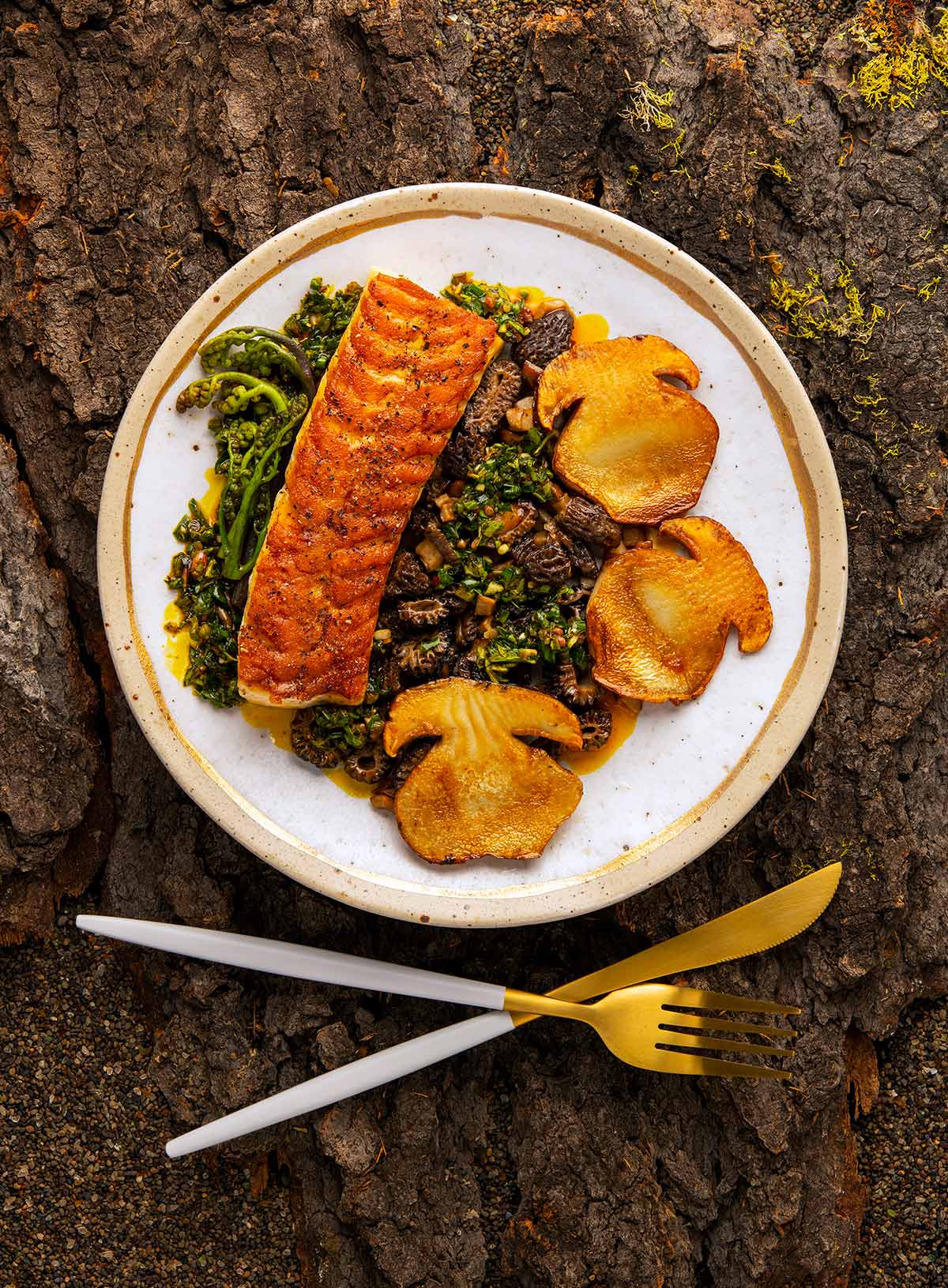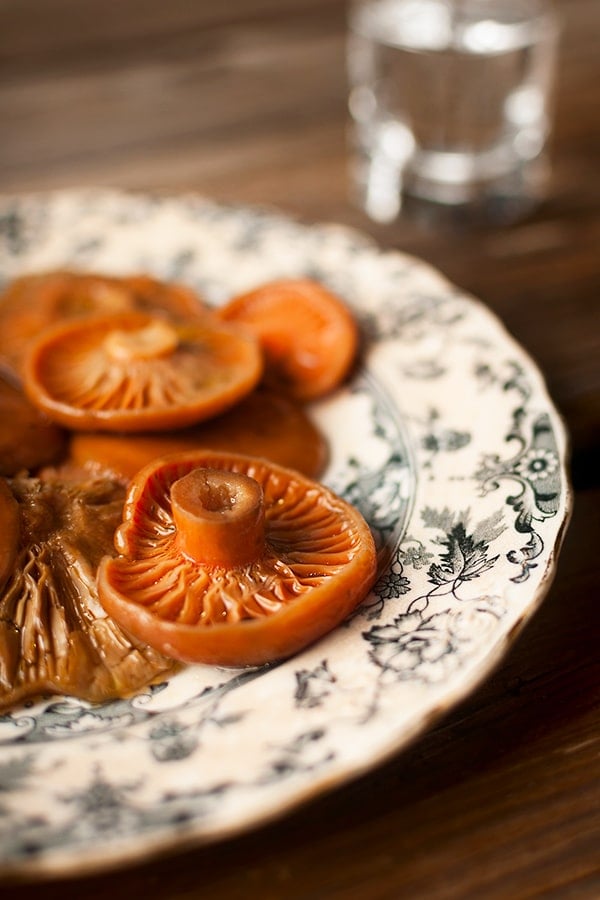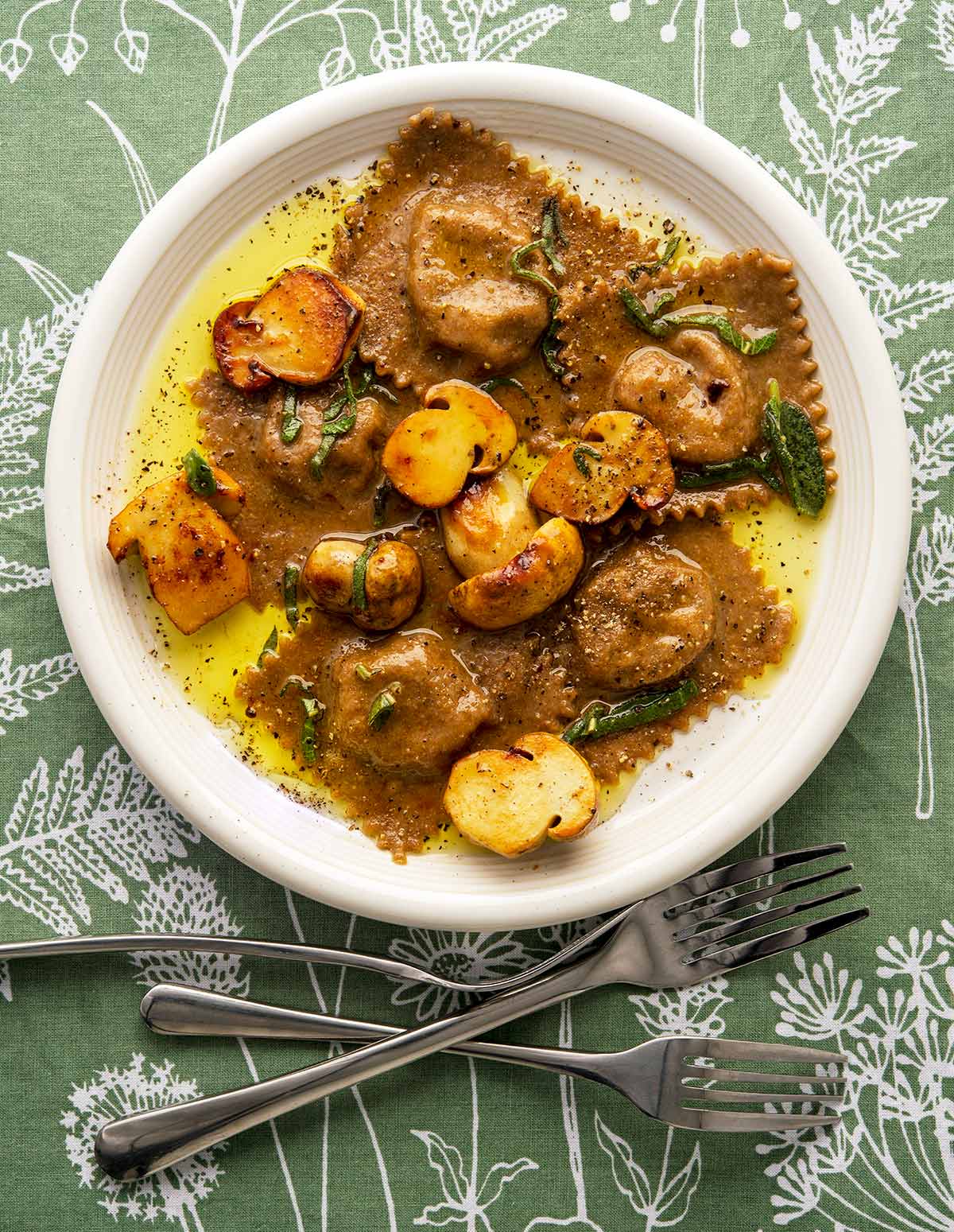Mushrooms
Mushroom Spinach Frittata
An easy Italian cross between an omelet and a quiche, this frittata is stuffed with wild mushrooms and wild spinach.

• About
• Gathering & Preserving: Basic Tips | Preserving Mushrooms | Gathering & Cooking Guides
• Recipes: Sauces | Pasta & Rice | Soups & Stews | Miscellaneous
If you’re looking for mushroom recipes, especially wild mushroom recipes, you have come to the right place: This is my collection of nearly 75 recipes where mushrooms are the star, or where they play harmony with other ingredients.
Some are fancy, some simple. Most of these mushroom recipes can be made with regular ole’ button mushrooms, or their brown cousins, the cremini; yes, they are the same mushroom, just grown differently.
The single best store-bought mushroom that matches the flavor intensity of wild mushrooms is the shiitake, so if you’re into mushrooms buy that one.
Virtually all mushrooms must be cooked, because even fully edible ones need their cell walls broken down by cooking to be fully digestible, and some, like morel mushrooms, are actually toxic if eaten raw.
Many mushrooms contain so much internal water you will want to toss them in a dry pan and “dry fry” them until they start giving up that water. Only then do you add butter or oil.
Mushrooms, being earthy, love wild game, beef, duck and other dark meat poultry. But some, like the matsutake, the enoki and the common white button mushroom, do go very well with fish and white meats.
Always save the water from rehydrating dried mushrooms. It’s full of flavor and, once strained of its debris, is great for soups, stews and cooking rice.
In general, multiply the weight of dried mushrooms by eight to get the equivalent weight of fresh. So 1/4 pound of dried porcini, for example, will be the equivalent of 2 pounds fresh.
Most mushrooms are best preserved by drying. This is not true for a few popular mushrooms, like chanterelles and chicken of the woods. These lose a lot when dried, and should be sautéed, then vacuum sealed and frozen.
I dehydrate my mushrooms in a dehydrator at about 110°F. You can put them on a rack in a hot garage, the back of your car in summer, or if you have to, a low oven. This is not ideal because you want to dry mushrooms, not cook them.
The next most common way to preserve mushrooms is to sauté them in butter or oil, with onions and garlic (or not), either in large pieces or as a classic French duxelle. You then cool, put in a vacuum bag, seal and freeze.
You can pickle mushrooms, too, and I am especially fond of pickled chanterelles. There’s also a hybrid technique from Italy where you salt mushrooms to remove some liquid, then boil in vinegar, dry them a bit, then preserve in olive oil. I prefer this style of marinated mushrooms for porcini.
Finally, you can lacto-ferment mushrooms, which is a brine pickle. I do this primarily with saffron milk caps, but you can use lots of different mushrooms.

These are guides to finding, safely identifying and cooking a few popular types of wild mushrooms.
Starting with chanterelles, which come out in summer in most of the United States, but in fall and winter in the Northwest. I wrote another article on yellowfoot chanterelles, a type of related mushroom.
Here are some tips on how to look for morel mushrooms in the West, and some pointers on looking for spring porcini.
Meadow mushrooms, Agaricus campestris, live all over, but they can be tricky to identify. Here’s how.
Here’s a guide to cauliflower mushrooms, and one for honey mushrooms.
Mushrooms of all kinds make for great sauces. Some of the best are the simplest, like a mushroom sauce for steak.
I do a specific morel sauce with venison that’s also great with beef or pork, and a rich mushroom ragu to serve with pasta or polenta.
I also make a simple mushroom sauce that works well with fattier fish, like trout, salmon or mackerel.

Mushrooms love to be with pasta or rice. Everything from risotto with porcini, morels or chanterelles, to Japanese matsutake rice.
I love mushroom ravioli, as well as mushroom tortellini, too. And you can never go wrong with mushroom pierogi.
This pasta recipe was made for chanterelles, but goes well with a variety of mushrooms, foraged or store-bought.
I have a range of soups and stews where mushrooms are either the star or a main player. Some of my favorites are a smooth chanterelle veloute, a wild mushroom bisque, a Spanish stew called chilindron, which uses lots of dried mushrooms, or a Russian stew with mushrooms, barley and a red meat like goose.
Mushroom fried rice is a simple, quick and easy recipe that works with any fresh mushroom, from buttons to morels, and whatever vegetable is in season when you make it.
Creamy mushrooms on toast is savory, rich, filling and definitely not low-fat. I am in love with this recipe! A recipe similar to this, only using egg as a binder, makes an incredible mushroom tart.
Mushroom spinach frittata is an easy “breakfast for dinner” recipe that works with any sort of fresh mushroom, and any sort of leafy green.
Wild mushroom stuffing is a must for the holiday season, and this especially satisfying version can be vegetarian.
Mushrooms
An easy Italian cross between an omelet and a quiche, this frittata is stuffed with wild mushrooms and wild spinach.
Pasta, Risotto, Gnocchi
An Italian classic. Squash gnocchi tossed with butter and sage, and, in this case, with wild mushrooms.
American Recipes
A versatile recipe for a savory bread casserole loaded with sausage, greens, cheese and mushrooms.
Mushrooms
An easy-to-make, vegetarian mushroom casserole with noodles that works with any sort of mushroom, wild or store-bought. Want meat? Add some!
French
This is a classic French mushroom sauce for steak based off a Julia Child recipe. Try it on your next venison steak.
Recipe
A versatile mushroom chili recipe so good you won't miss the meat. In fact, the finely chopped or ground mushrooms taste like meat. And you can add meat if you like!
Mushrooms
Grilled mushrooms are a great way to move what's normally a cold weather ingredient outdoors. This recipe works with any meaty mushroom.
Pasta, Risotto, Gnocchi
Classic pasta primavera the way Le Cirque used to make it back in the 1970s: Angel hair with fresh spring vegetables and cream.
Recipe
Can you get any more Minnesota than wild rice hotdish? Pretty sure you can't. This easy comfort food casserole is a hat tip to the North Star State, and can be made "wilder" with venison and wild mushrooms.
Mushrooms
This is a simple garlic roasted mushroom recipe that works with any meaty mushroom, from porcini to shiitake to regular button mushrooms.
Mushrooms
When life gives you mushrooms, make tortellini out of them. I love these little packets of love, and making them with wild mushrooms is especially lovely.
Mexican
A recipe for huitlacoche quesadillas. Huitlacoche, "corn smut," is a mushroom that grows on corn, and is amazing cooked with chile and onion on a tortilla.